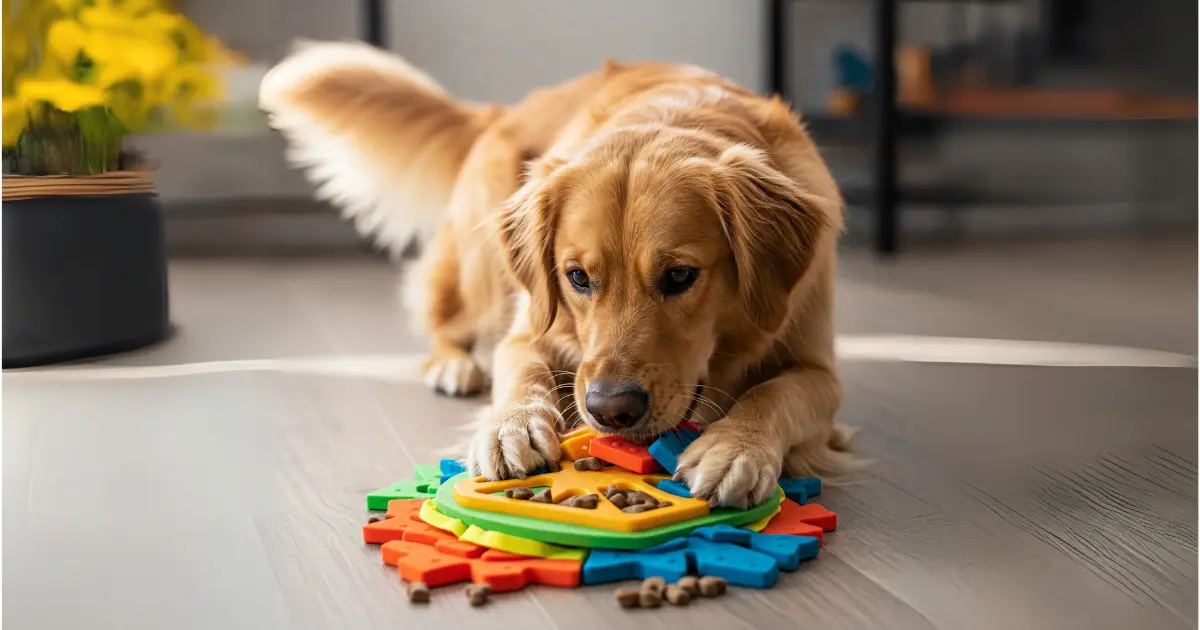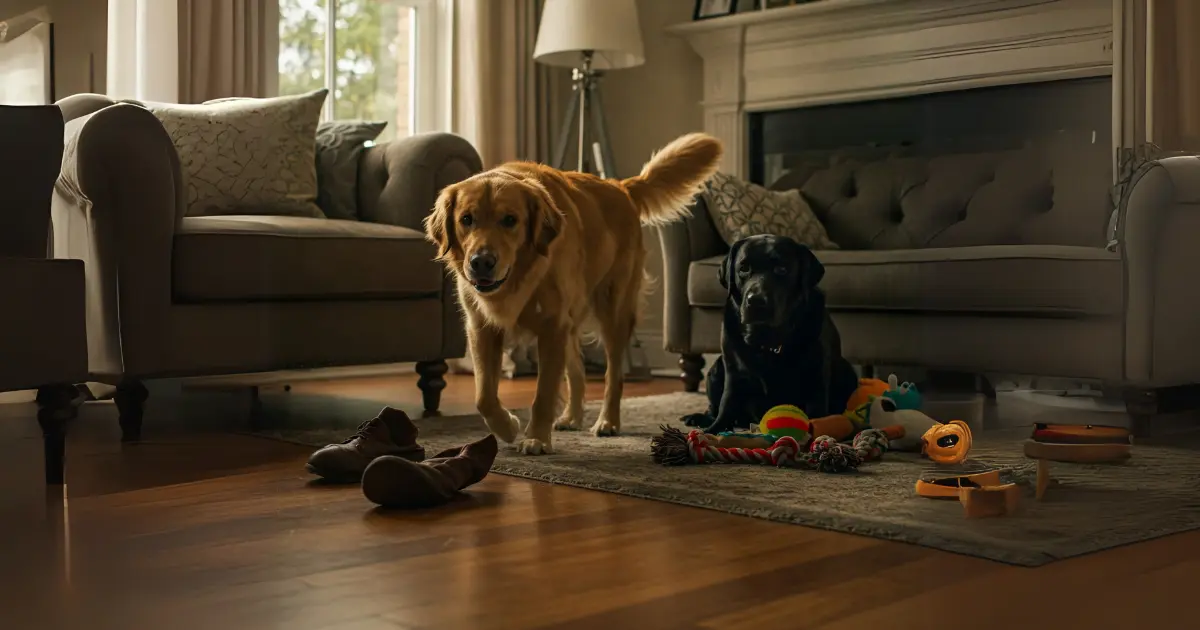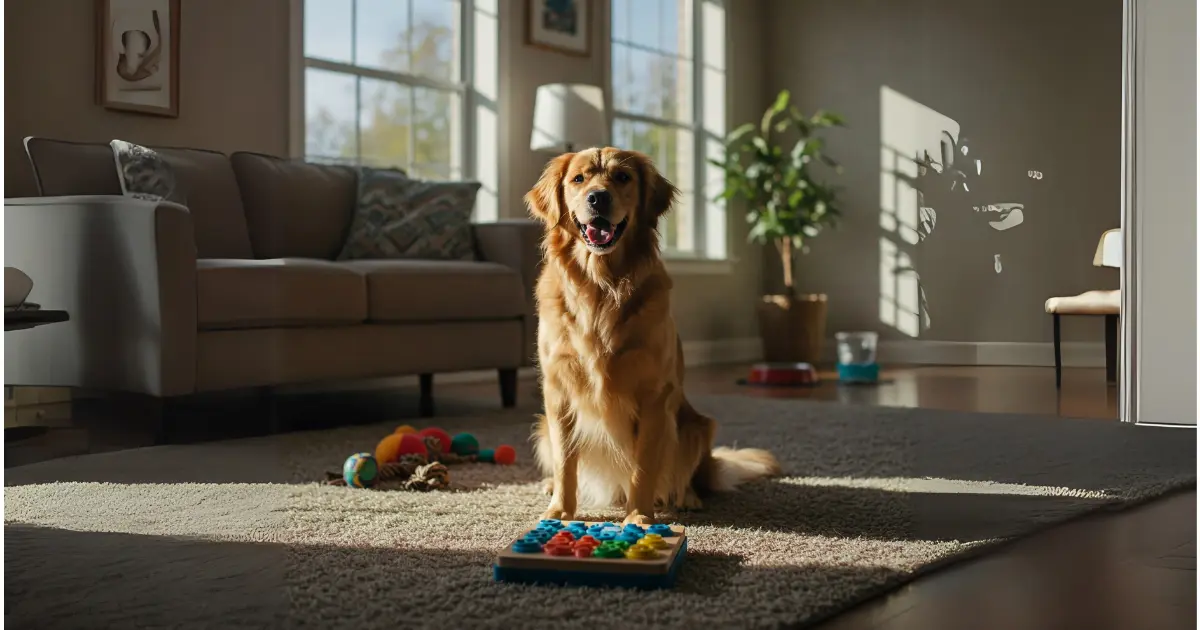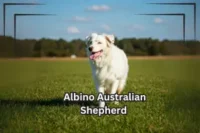Mental Stimulation for Dogs: Best Mind Games and Puzzle Toys
Published: 30 Jan 2025
Dogs need physical exercise to stay in shape, but what about their brains? Just like us, mental stimulation for dogs helps them stay sharp and content. Engaging their minds with fun activities can help prevent boredom, reduce anxiety, and improve behavior. In this guide, I’ll walk you through some of the best ways to give your dog the mental exercise they need through games, puzzles, and activities. Trust me, both you and your dog will enjoy these!

Table of Contents
Why Dogs Need Mental Stimulation
Understanding Mental Stimulation
Mental games for dogs involve activities that make them think and solve problems, like keeping our minds active with puzzles or reading. These activities really get your dog’s brain working and give them a sense of accomplishment when they figure things out. Dr. John Smith, a vet I trust, often says, “Dogs are naturally curious. Their intelligence shines when they’re given puzzles to solve.” It’s so true! Whether they’re using their nose, paws, or their sharp problem-solving skills, these games make life more exciting and rewarding for them. I’ve seen it in my own dog—watching them crack a puzzle is like seeing a light bulb go off in their head!
The Benefits of Mental Challenges
When you add mental exercises to your dog’s routine, you do more than keep them entertained. Here’s how it helps:
- Reduces Destructive Habits: A bored dog is often a destructive one. When mentally stimulated, dogs are less likely to chew on shoes or dig up your garden.
- Improves Focus and Obedience: Brain games keep your dog sharp, which can enhance their ability to follow commands.
- Decreases Anxiety: Giving your dog challenging tasks can distract them from stress or fear.
- Boosts Cognitive Health: Just like humans, dogs’ brains benefit from regular workouts, helping maintain mental agility, which is why engaging their minds through games and puzzles is crucial. You can learn more about their fascinating capabilities in our post about fascinating dog facts.”

Signs Your Dog Needs Mental Stimulation
If your dog is constantly looking for things to do, chewing everything in sight, or acting restless, they might need more stimulation. On the other hand, If your dog is becoming overly bored or lethargic, it could be a sign they need more to do. Some dogs are naturally lazier than others—read more about how to identify and manage lazy dogs.” Here are a few signs:
- Excessive pacing or wandering
- Destructive behavior (like chewing or digging)
- Barking or whining when left alone
- Loss of interest in toys and playtime
Mental Exercise Ideas for Dogs
Interactive Games
Interactive games are one of the easiest ways to engage your dog’s mind. Not only do they provide mental stimulation, but they also help strengthen the bond between you and your pet.
- Examples of Fun Games:
- Hide and Seek: A simple and effective game where you hide a treat or toy and motivate your dog to find it. If you’re looking for more ways to keep your dog mentally and physically healthy, check out our dog care tips for ideas.”
- Fetch with New Commands: Spice up the classic fetch by incorporating commands such as “sit” or “down” before throwing the ball.
- Tug-of-War with Commands: This tires your dog out and gives them a chance to practice self-control with “stop” and “drop it” commands.
Puzzle Toys
Puzzle toys are best for dogs who love challenges. These toys are planned to hide treats or require your dog to figure out how to get a reward, making them mentally stimulating.
- Examples of Puzzle Toys:
- KONG or similar treat-dispensing toys
- Nina Ottosson Puzzle Games
- Trixie Activity Toys for problem-solving
Training Sessions
Training sessions aren’t just for teaching new tricks but also for stimulating your dog’s brain. Practicing commands or teaching new fun skills helps keep their minds active and can also improve their behavior.
- Fun Training Ideas:
- Basic Commands: Revisit essential commands like “sit,” “stay,” or “come.”
- New Skills: Challenge your dog with new tricks such as “rollover” or “play dead.”
- Find the Object: Testing their memory and problem-solving abilities. Hide an object and ask your dog to get it back.

Best Mind Games for Dogs
1. Hide and Seek
This game is a winner in any dog household. Hide a treat or toy, and let your dog use their nose to find it. It’s a great way to get them thinking; they’ll love the challenge!
- How to Play:
- : Show your dog a treat or toy.
- Hide it while they’re distracted or out of the room.
- Please give them the command to search, and watch them go to work!
- Pro Tip: Start with easy hiding spots and gradually make it more challenging as your dog’s skills improve.
2. Tug-of-War with a Twist
Tug-of-war is a fantastic method for physically engaging your dog, but you can make it more mentally stimulating by adding commands. Ask your dog to pause and wait during the game, reinforcing their training and focus.
- Pro Tip: Keep tugging sessions short so your dog doesn’t get overstimulated. Use this game as a bonding time.
3. Scent Games
Dogs have an acute sense of smell, and scent games fully exploit that. You can hide treats around your house or yard and let your dog use their nose to find the hidden treasures.
- How to Play:
- Place treats or kibble in several locations.
- Allow your dog to sniff out the hidden food.
- Steadily increase the difficulty by hiding the treats in harder-to-find places.
- Pro Tip: If your dog struggles, place the treats in easy-to-find spots and slowly work up to more challenging hiding places.

Top Puzzle Toys for Dogs
1. Interactive Treat Dispensing Toys
These toys are perfect for when you want your dog to work for their treat. Toys like KONG or Busy Buddy encourage your dog to think and manipulate the toy for reward.
- Pro Tip: Stuff the toy with peanut butter or their favorite treats to keep them engaged longer.
2. Snuffle Mats
A snuffle mat is a magic tool for engaging your dog’s sense of smell. By hiding treats in the fabric folds, you can create a mini treasure hunt for your dog.
- Pro Tip: Snuffle mats are also great for calming anxious dogs. Let them work through it slowly to relax and focus.
3. Puzzle Balls and Blocks
Another excellent choice is to require your dog to solve a challenge to access the treat. Max, my dog, absolutely loves the Nina Ottosson Dog Tornado—he’ll spend ages spinning the pieces to get the treats out!
- Pro Tip: Start with simple puzzles and move to more complex ones as your dog gets better at solving them.
4. DIY Puzzle Toys
Sometimes, you don’t need fancy toys to engage your dog mentally. I love making my puzzles at home—Max gets such a kick out of them!
- DIY Ideas:
- Hide treats in an egg carton and close the lid.
- Use a muffin tin, place treats in the cups, and cover them with tennis balls.
- Roll up a towel and hide treats inside for your dog to unroll.
Tips for Effective Mental Stimulation
- Don’t Overwhelm Them: Start with more manageable tasks and gradually increase the difficulty as your dog gets the hang of it.
- Make It Fun: The aim is to make the activities enjoyable, not stressful.If your dog starts getting frustrated, try simplifying the challenge. Sometimes, less is more!
- Consistency Is Key: Add mental stimulation into your dog’s daily routine, even if it’s just for 15–20 minutes.
- Balance with Physical Exercise: While mental workouts are great, it’s just as important to make sure your dog gets plenty of physical exercise—whether it’s a walk, a run, or some playtime outside.
Conclusion
Keeping your dog’s body healthy is important, but don’t ignore their mind, too! A happy, well-rounded dog needs mental activities just as much as physical exercise. Whether you’re hiding their favorite toy, playing a round of hide-and-seek, using puzzle toys, or training them a new trick, these activities give your dog the mental challenge and excitement they grow on. It keeps them sharp, entertained, and engaged. And honestly, it’s a win-win for both of you—But don’t forget, their diet plays a crucial role in brain health, too. To learn more about the best foods for supporting cognitive function, check out this article on dog nutrition and brain health.”
What’s your dog’s favorite mental game? Drop a comment and let me know—I’d love to hear all about it!
FAQ
1. How can I tell if my dog is mentally under-stimulated?
If your dog chews shoes, digs in the garden or seems overly restless, it’s a sign it needs more brain exercise. Sometimes, all it takes is a fun game to keep its mind busy and happy.
2. Can mental stimulation help if my dog has separation anxiety?
Absolutely! Providing mentally engaging activities like puzzles or hide-and-seek can distract your dog when you’re gone, helping ease their anxiety. It’s like giving them a job while you’re away calms them.
3. How often should I make my dog work their brain?
You don’t need to go overboard! Just 10-20 minutes a couple of times a day is plenty to keep your dog’s brain sharp. It’s about consistency, not overwhelm.
4. Are puzzle toys safe for puppies?
Yes, but keep it simple at first. Puppies are still learning to navigate toys, so start with softer, easier puzzles and gradually introduce more challenges as they grow.
5. What puzzles are best for my older dog?
Older dogs might not be as quick on their paws, so try puzzle toys that aren’t too complicated. Something like a treat-dispensing ball or a snuffle mat will keep them entertained without too much effort.
6. What if I don’t have toys—can I still challenge my dog mentally?
Definitely! Try hiding treats around the house or teaching them a new trick. Simple activities like scent games or just playing “find the toy” can mentally enrich without needing toys.
7. My dog gets frustrated with puzzles. What can I do to help?
That’s normal! Start with easy puzzles and gradually make them more challenging. Also, try playing with them so they see it as fun, not frustrating. A little patience goes a long way!
8. Can mental exercises tire my dog out like physical play does?
Yes! Mental challenges can be just as exhausting as physical ones. If your dog seems wiped out after a brain game, it means they’ve been working hard, so balance it out with some physical play, too.
9. Are all dogs into brain games?
Not every dog is a puzzle enthusiast! Some breeds love a good challenge, while others prefer simple games like fetch. It’s about finding what makes your dog tick.
10. Can mental stimulation replace walks and outdoor playtime?
While mental games are great, they shouldn’t replace outdoor exercise. Dogs need physical and mental activity to stay healthy and happy, so keep up those walks alongside brain-boosting fun.

- Be Respectful
- Stay Relevant
- Stay Positive
- True Feedback
- Encourage Discussion
- Avoid Spamming
- No Fake News
- Don't Copy-Paste
- No Personal Attacks



- Be Respectful
- Stay Relevant
- Stay Positive
- True Feedback
- Encourage Discussion
- Avoid Spamming
- No Fake News
- Don't Copy-Paste
- No Personal Attacks





